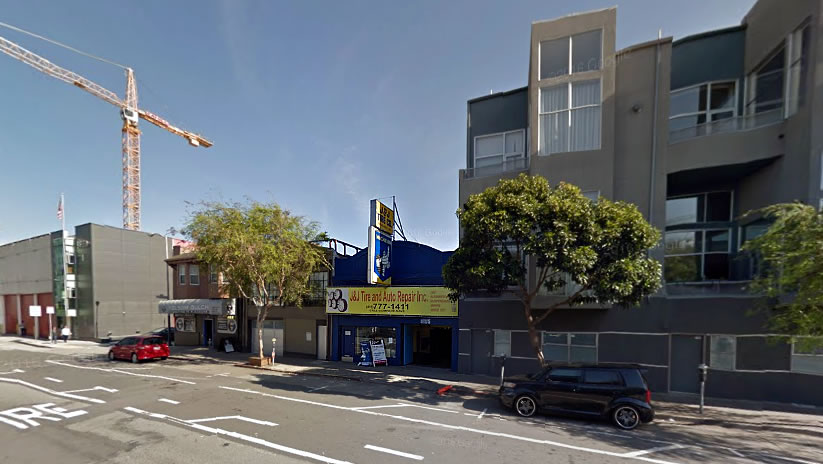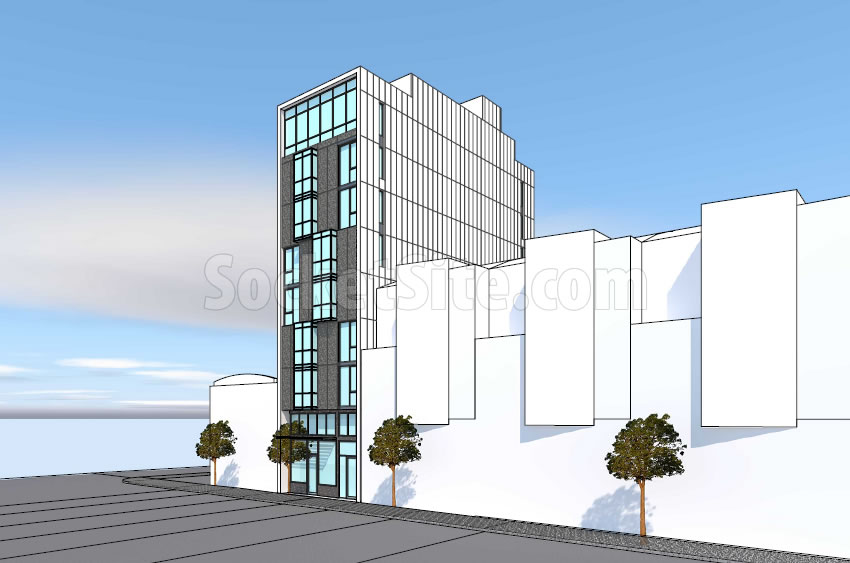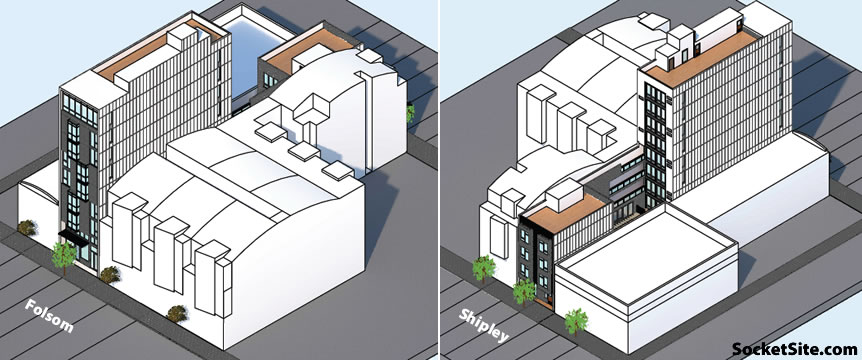Plans to raze the J & J Tires and Suspension shop building at 955 Folsom Street, two doors down from Folsom Gulch, have been drawn. And as proposed, an nine-story building with 18 condos over a 1,000-square-foot retail space will rise up to 85 feet in height at 953 Folsom Street, which is the second address for the South of Market site.
The new building would front Shipley Street as well, but would step down to four stories on its southern side.
And in terms of parking, the proposed building does not have a garage but there is a storage room for 18 bikes.



so sick of these step downs
More lost PDR space that offered jobs for blue collar workers. The replacement retail/service space will offer jobs that won’t be filled, because few can afford to live on SF on the wages that retail and service jobs pay.
Yeah, let the robots make our lattes.
Two tears in a bucket for the 4 mechanic jobs and $140k in annual wages lost for SF.
Ok, four here, four there, a dozen over there, twenty across the street….hundreds of stable blue collar jobs have been gutted from the eastern neighborhoods.
SF has lost 100,000 PDR jobs over the last 40 years, during which PDR jobs went from roughly 4 out of 10 jobs in SF to about 1 in 10. A lot of those jobs and those workers went to the east bay. SF has replaced those jobs with more and higher paying jobs, on average. “This land is too valuable to permit PDR to park on it.”
You are describing class war. It’s a silent, unilateral class war, but it’s class war nonetheless.
Is it a class war or is it a changing economy?
We’ve also lost buggy whip manufacturers and (less facetiously) shipbuilding. New England has lost textile manufacturing. Etc. Etc. Etc. It ain’t class warfare, it’s the way the world works.
Class War? You need to cut back on your intake of Fox “News”.
Except Fox News gets it backwards – they claim that it is the rich and powerful who are the victims of class warfare.
The disappearance of blue collar jobs – especially in expensive urban areas – is not class warfare. That is a simple matter of broad economic trends. There is true class warfare that has affected this group, however, as well as the broader wage earner class, in the systematic dismantling of labor rights, the decline in the minimum wage and overtime, gutting employee protections (through arbitration clauses, etc.) and a host of other legislative and judicial actions. Trump has tapped into the zeitgeist for this group (although, to my knowledge, he does not support a single policy that will actually benefit them – but who needs policy when you can just proclaim things like “we will bring back the steel jobs”?). Holding on to industrial space in the middle of San Francisco won’t change that either, and is not a good use of this space.
what JR”Bob” Dobbs is very true (why the quotes around Bob?)
But more so what we all should be thinking about is what with robotics, off shoring to areas of cheaper labor, what is going to happen to the growing population of workers in the near future, not only here in the US but the whole world. There are places where unemployment rates are 25-40%, what do people do in those instances, starve? migrate? start a revolution?….scary future unless all of us start to think about the economic systems that we are part of..
An increasing amount of “slack” is perhaps inevitable, as I, JR “Bob” Dobbs, have always said.
No easy answers. Some thoughts: broader employee rights, stronger unions, minimum basic income, higher taxes on the wealthy and a broader safety net, increased government employment/spending for infrastructure, etc. I suppose “let them starve” is another option, but not a civilized one IMHO (and one that will result in ugly, armed revolt eventually).
Indeed, a purely market driven economy will result in an early visit from the Stark Fist of Removal.
Another huge issue is the changing pattern of shopping. To on-line vehicles. Amazon just had a great quarter while Target and Wal-Mart are near saturation levels. Specialty stores, the kind that used to fill many of these spaces, is/will be especially hurt in the new shopping reality. .
As it is, many of the ground floor retail spaces in new SF projects sit empty for long periods. This will only get worse as shopping patterns continue to change. So the displacement of PDR space in many of these projects is doubly problematic.
If you feel so strongly, maybe you should buy the place and propose a PDR use… that is the problem with SF, onlookers always have an opinion but no skin in the game.
Ah, the good ol’ skin in the game fallacy.
But I do have skin in the game: I live in SF.
If you do the math, only the top 2-3% of households in America can afford the monthly outlay for the median SF condo. Blue collar is so far out of the game it’s ridiculous. That’s why the solutions being pitched are state sponsored vs market based: higher minimum wage and affordable housing. So with the Fed giving handouts to the wealthy and the City giving handouts to the poor, guess who loses out once again? Yep, the sucker middle class.
True at a national level, but real estate is local and there are many markets in which the typical blue collar worker can afford the median priced home.
The dilemma for blue collar workers here, and even increasingly for tech workers is, do I stay and probably forever rent or do I move on. Not an easy choice and especially if one has ties to the Bay Area. it is easier though if one is younger.
Yes I was talking about SF. There’s no dilemma. Unless you have rent control or are willing to bunk up, the only choice is to leave, because you’re simply not gonna make it paying market rents with blue collar income.
Its not just blue collar either. I know half a dozen tech workers who have ;left in the past year as they can’t afford a home here. Despite making 100K plus.
The bunking up has hit my neighborhood. A number of folks rent out bedrooms to young single tech workers and several near me are trying to find jobs in other areas.
The middle class is the sucker in a way. I would not mind paying taxes but am dismayed by how the money is wasted. The cost overruns/delays for the TBT and the BB are prime examples.
IMO and experience real estate investing is the one vehicle middle class folk have to take advantage of some of the breaks the upper income folks get.
Here’s a new article with fun facts and charts about the middle class being pushed out of cities.
Interesting read. On a positive note, there are still many affordable cities in the US. Not on the coasts so much – but for Portland but it is not really on the coast.
The whole point of the western soma plan was preserving PDR space while keeping height to a minimum. You can’t look at this space tiny space individually. Maybe read up on the plan and educate yourself.
Yep, it’s the right move.
And what’s the cost? A 15-20 minute bart ride into the city from Oakland? It works for manhattan…
the biggest problem with the housing shuffle is that bay area transit doesn’t hold a candle to new york. i support this development, but implying our transit infrastructure can achieve the same equitable success without massive reinvestment — that, my friend, is a serious delusion, and one shared by many bay area residents.
Agreed. For all the tax dollars we’re getting from high end property, you would think we’d get better transit.
That’s mainly because a lot of people who own high end property aren’t taking transit.
Yep. Like me – I walk.
The idea that PDR jobs are “lost” is erroneous. They have simply moved across the Bay or down the Peninsula. When a job moves from Manhattan to Brooklyn no one thinks of it as being lost, its still in the city. The SF problem is not that the job moves but by accident of history, SF and Oakland grew up as separate municipalities. If Oakland were a borough of SF, no one would belly ache.
Excellent point
the main between the bay and nyc difference is transit infrastructure. see above. if residents could get from Richmond to SOMA like people can get from Queens to Manhattan … you’re right, no one would belly ache. that scenario is very far off, though, and requires lots more transit investment.
Not all those jobs moved within the Bay Area. Thousands of SF PDR jobs were lost to automation, they moved into history. Thousands more moved out of the USA. Not many garment mfgs in CA these days. And we need fewer gas stations, as well as tire and repair shops like this one, as cars improve.
I guess we could tell Paul Allen that the idea his Blazers “lost” last night is erroneous. The victory simply moved over to the Warriors. One big NBA zero sum win-loss count. That’ll bring back his smile.
Oakland is a suburb of SF, always has been. Most of the PDR jobs that left SF for other parts of the Bay Area did not move to Oakland or the Peninsula. San Mateo and Santa Clara Counties have also lost PDR jobs over the past 40 years, and continue to “lose” PDR jobs. PDR jobs have increased in Hayward, Fremont, Patterson, Modesto, Stockton, …
The irony is that this residential building will probably create more jobs than were lost by the mechanic’s shop it replaces. Think housekeepers, repair staff, cooks, nannies, etc.
Are these really PDR jobs? Seems more akin to the service industry. The displaced workers cannot simply commute in to SF. San Franciscans will have to go to them to be serviced.
Apropos of nothing, I suppose, but that newish residential building next door sure makes for a crappy pedestrian realm.
Exactly. The streetscape in almost all of these new SOMA developments is AWOL. The intimacy, the engagement – short of that, one wants to get past these sidewalks/streets as fast as possible and one is not be drawn in. To the shops, to the street life, to the neighborhood – such as it is..
Where are the shrubs!
The Bay Area is a REGIONAL economy – the 4 mechanic jobs here may have been replaced by 10 mechanic jobs in Hayward and Fairfield. It’s time to stop thinking about SF as an island (much less SoMa as an island) – this project will provide what the REGIONAL needs most – housing near transit.
For those wondering what SF means by PDR, from a recent SF Planning doc for central SoMa (namelink):
“PDR is a term used to describe a whole range of non-residential uses that don’t fall into other categories, such as office, retail, and institutional. This includes the production or manufacture of things (such as clothing, food, and art), the distribution of people and things (as undertaken by wholesalers, UPS, MUNI, etc.), and the repair of things (the work of auto mechanics and plumbers, for example).” – Central SoMa Draft Policy Document; Production, Distribution, and Repair; November 2014
This document also has a breakdown of the ~60k PDR jobs in SF as of 2012, including 2600 in auto repair.
One more time: housing is critically needed; build it now.